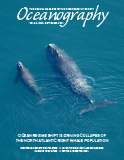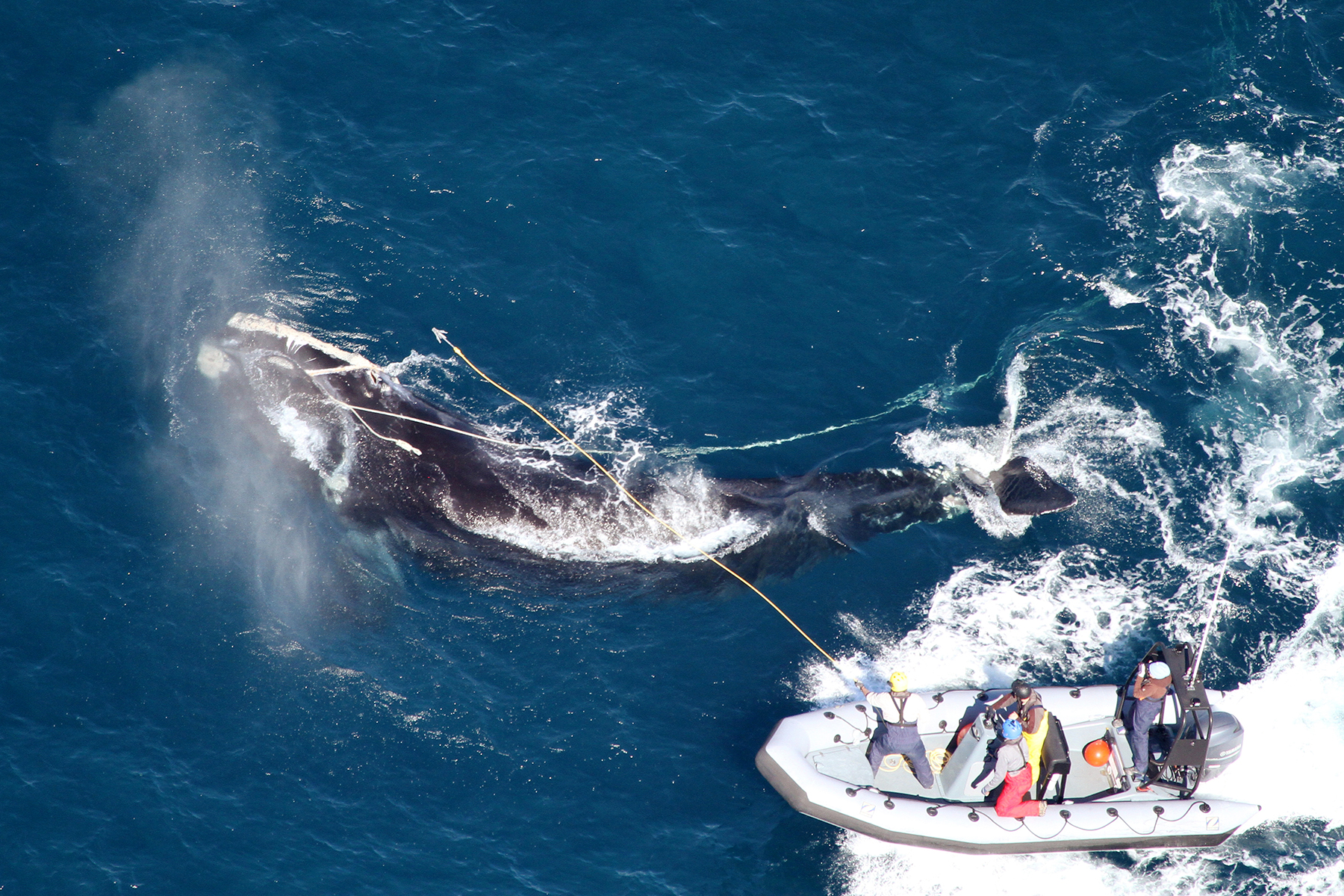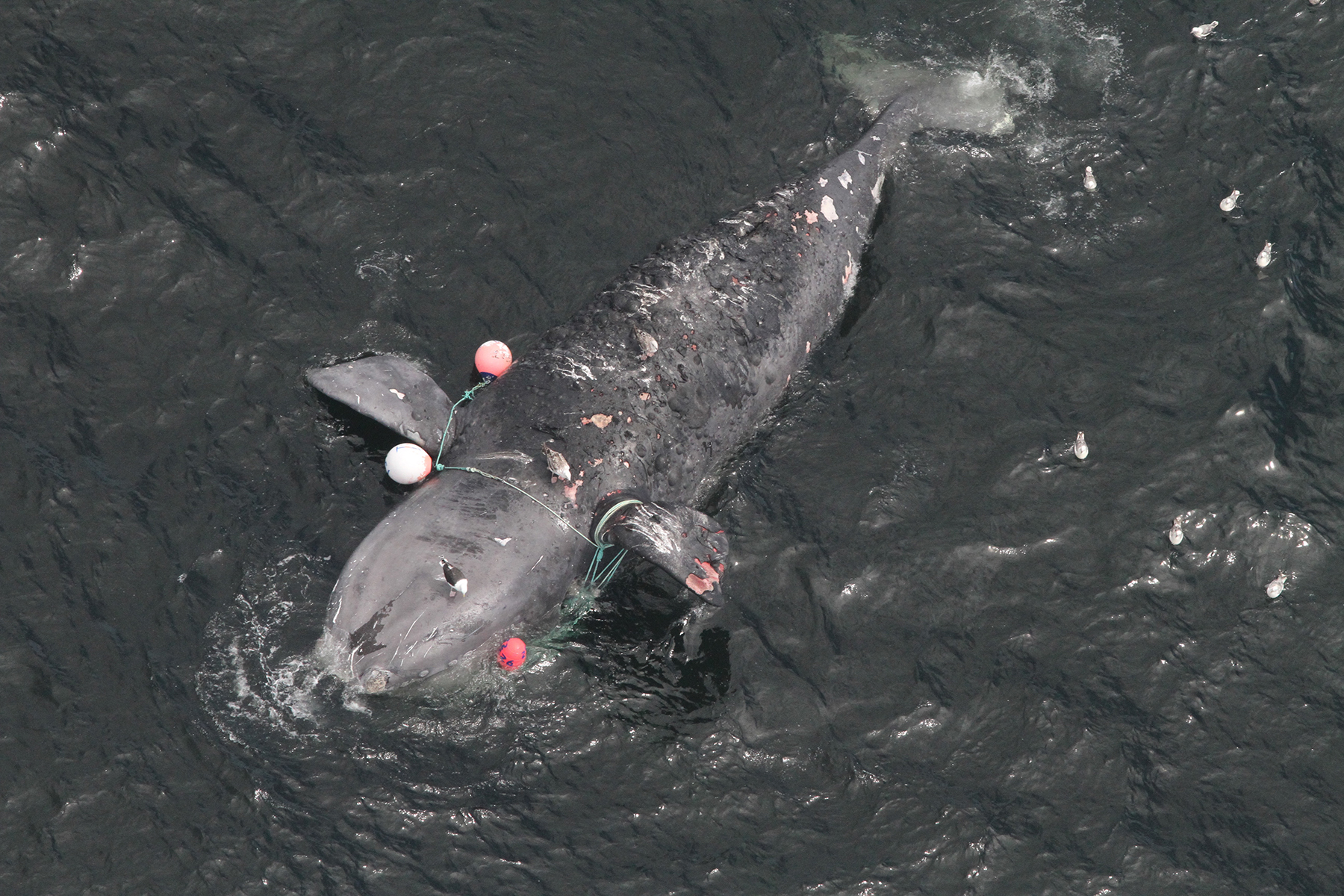Full Text
Climate change is forcing critically endangered North Atlantic right whales into conflict with commercial fishing gear—and the whales are suffering devastating losses. Entanglement response teams take great risks to rescue individual animals, but they cannot save the species. |
|
|
“One step and you’re bait” is a cautionary maxim used by the Campobello Whale Rescue Team. It’s a fisherman’s saying, which makes sense because commercial fishermen have always been part of the team, including Mackie Greene and Joe Howlett, who formed it in 2002 with the support of the late Jerry Conway, a Fisheries and Oceans Canada (DFO) marine mammal advisor.
Lessons learned dropping trawls of heavy traps translate directly to handling lines attached to struggling 50-ton whales. In either situation, one step into a coil of running line offers an excellent chance to experience what Herman Melville noted in Moby-Dick as the fate of many an old-time whaler: “a speechlessly quick chaotic bundling of a man into eternity.”
New entanglement responders quickly develop catchpoint paranoia. “Always be checking your PFD,” says Greene. “No strings or buckles hanging, no rings on your fingers. Make sure you and everybody else is clear of the line. And make sure it’s not caught on the boat.”
The Campobello team’s old boat was missing the safety line that is standard on Zodiacs. “We had a carabiner get caught in the lifeline when the other end was attached to a big right whale,” says Greene. “Pop, pop, pop, just tore the lifeline right off.”
Working from small boats down at blowhole level, entanglement responders typically first grapple onto whatever is wrapped around a whale. They then use the ancient whaling technique of adding drag to attempt to slow the whale—a method modernized in 1984 by Charles “Stormy” Mayo and Dave Matilla at Provincetown’s Center for Coastal Studies.
Over the years, responders have also designed custom cutting grapples as well as fixed and flying (detachable) knives that are wielded on long rescue poles. They’ve even repurposed and modified weapons like broadhead crossbow bolts into lifesaving tools. Once a team readies to cut a whale free, though, it still almost always means entering what they call the danger zone.
In the Western North Atlantic, the two large whales that responders most frequently work on are humpbacks and North Atlantic right whales (NARW). Both are “fight” species willing to confront perceived dangers as opposed to “flight” species like blue whales, finbacks, and minkes that try to outrun threats. Humpbacks are armed with the world’s longest pectoral fins, and NARW with intimidating skulls, but for both species their main weapon is the tail. The flukes may appear floppy from a distance, but Stormy Mayo—who’s found them in his lap during disentanglements—describes them as feeling like “an innertube filled with lead.”
Of the two species, NARW, Eubalaena glacialis, are considered much more dangerous to approach. “A humpback will easily kill you,” says Mayo, who’s worked on dozens of both species. “But a right whale will absolutely squash you.”
As stout as they appear, NARW are remarkably flexible. “A right whale can take its fluke and touch it to its nose,” says Scott Landry, Director of the of the Center for Coastal Studies’ Marine Animal Entanglement Response Program. “So, any threat that approaches its head is going to be crushed.”
Unfortunately for responders, NARW often encounter fishing gear while feeding, and ropes typically get caught in their mouths. This usually requires maneuvering into the whale’s kill zone to cut them free.
“And if that whale wants to take a swipe at you,” says Mackie Green, “there’s not much you can do except try and get the hell out of there as quick as you can.” Mackie pauses for a tough moment after saying this, and then adds: “Something else that’s now in the book is that when things go bad, the whale’s close, and things start slapping, everybody should try and lay down and get some protection from the sides of the boat.”
That new protocol is in there because of what happened to his friend and teammate, Joe Howlett.
Tales of the strength and stubbornness of NARW seemed apocryphal until a whale named Ruffian proved all the legends true.
With estimates of fewer than 360 NARW remaining (NARWC, 2021a), researchers know practically every individual in the critically endangered population and have given many of them mnemonic nicknames so they can be recognized on sight. Ruffian is a big male born in 2004 and badly wounded at age five by an entanglement, leaving him with tough guy scars.
In January 2017, a survey plane spotted Ruffian off the southeast US coast with a thick line running through his mouth and taut across his back where it chewed at a raw, gaping wound. In disentanglement triage, a line through the mouth or a constricting wrap around any body part is considered life-threatening. A line around the head can prevent the animal from feeding, and it will slowly starve. A wrap around flippers or tail will gradually, excruciatingly saw through flesh and bone until it amputates the limb. Body wraps can flense skin and blubber, leaving the whale to bleed out or die from infection unless the drag from the gear drowns or starves them to death first.
“Of all the ways we kill wild animals, this has got to be the worst—slow and gruesome,” says Michael Moore, a veterinarian and director of Woods Hole Oceanographic Institution’s Marine Mammal Center. Moore has performed necropsies on 43 right whales, literally wading into the damage we’ve done to look for solutions. “It’s torture.”
From studying scars, researchers have determined that nearly all NARW have experienced this torture. At last count, 87% of them have been entangled at least once, 59% more than once, and some individuals have been caught in fishing gear more than six times (Hamilton et al., 2019).
|
|
Ruffian was one of the lucky ones. In a two-day operation, disentanglement crews from Georgia and Florida successfully cut him free. The tackle they collected was snow crab gear from the Gulf of St. Lawrence. That means Ruffian swam at least 2,575 km while hauling 137 m of thick line that bit into him every time he beat his tail. Even more amazing, the 61 kg metal crab trap was still attached and likely dragging along the bottom whenever he swam into shallow water during the months-long ordeal. That incredible feat of strength, stamina, and pain tolerance is testament to the right whale’s will to survive.
Left alone, a NARW might live 80 or more years like their southern right whale cousins. We may never discover their true potential lifespan, however, because they’re dying long before reaching old age. Particularly dire for the species is that ship strikes and entanglements are killing two-thirds of NARW females before they’re 30 years old—robbing the population of decades of reproductive potential.
Migrating up and down the highly industrialized East Coast to give birth in warmer waters—crossing shipping lanes and fishing grounds webbed with millions of entangling lines—is a risky proposition. Females are getting killed at 2.5 times the rate of males. There are now fewer than 100 reproductive NARW females, and their average calving intervals have jumped from three to 9.5 years (NARWC, 2021b), likely due to injuries from sublethal entanglements and climate-induced variabilities in food distribution forcing longer migrations.
The math is as clear as it is bleak. Since 2011, there have been approximately 240 NARW deaths to only 132 births. Researchers estimate that if current mortality rates persist, the species could be functionally extinct in a matter of decades (Meyer-Gutbrod et al., 2021, in this issue). And it’s all on us. Astonishingly, not a single adult North Atlantic right whale is known to have died of natural causes in the last 50 years.
NOAA’s National Marine Fisheries Service (NMFS) and Canada’s DFO agree that the potential biological removal (PBR) for NARW is less than one whale: a single mortality per year from entanglement or ship strike is enough to threaten population recovery. According to the results of a new study on cryptic mortality (Pace et al., 2021), we’ve overshot PBR by an estimated 2,500% every year. And, as stated in the 2018 NARW Consortium Report Card (Pettis et al., 2018), from 2010 to 2016, 85% of right whale mortality was due to entanglement.
As hard as entanglement responders work and as creative as the tools and techniques they’ve invented, they’re relatively powerless in holding back this rising tide of death. Only about 10% of large whale entanglements are reported, which extrapolates to an estimated 1,000 large whales of all species injured or killed by fishing gear each year in US and Canadian waters. NMFS reports that in 2018 the response network was able to partially or fully disentangle only 16 large whales out of 105 confirmed US entanglements.
Despite these seemingly hopeless numbers, every rescued North Atlantic right whale counts. When Philip Hamilton, senior scientist at the New England Aquarium, queried the NARW catalog in 2019, he found that more than 10% of the entire living population was made up of whales freed from entanglements by response teams along with the calves those whales subsequently produced.
“We’re fighting to save this species one whale at a time,” says Moira “Moe” Brown, senior scientist at the Canadian Whale Institute and science director for the Campobello Whale Rescue Team. Thus, response teams on both sides of the border continue to train, to innovate, and to launch when called.
When Brown’s Campobello teammate Joe Howlett and the science crew aboard R/V Shelagh motored into the Gulf of St. Lawrence on July 10, 2017, they sailed directly into the middle of the worst calamity to befall North Atlantic right whales since the end of commercial whaling.
A highlight of Howlett’s year was taking time off from fishing and running whale watch boats off Campobello Island to captain right whale survey cruises aboard Shelagh, a beamy 45-foot trawler that served as floating Nirvana for whale nerds. “Joe loved it out there, loved the whales,” says Brown. “And on research cruises he got to be at sea without the pressures of commercial fishing.”
They were supposed to be out there to count and ID animals and sample their food source to inform future management decisions in the hope of preventing human impacts. But suddenly it was all-hands-on-deck to save individual whales.
Moe Brown, Jerry Conway, and their colleagues on the US side of the border had worked for decades to create whale conservation areas, shift shipping lanes, and adjust fishing seasons to protect NARW in their summer feeding grounds—
primarily the Gulf of Maine. Whales regularly showed up in Cape Cod Bay in the spring and then moved up to the Bay of Fundy for the summer. “Then in 2010, we saw this habitat shift,” says Brown. “Whales started showing up earlier and in bigger numbers in Cape Cod Bay, but once they left in the spring, they mostly disappeared.”
|
|
A Continuous Plankton Recorder survey program has operated in the Gulf of Maine since the 1950s, measuring concentrations of NARW’s preferred copepod prey. However, cutbacks in NOAA’s budget left the samples uncounted during a critical time for those trying to figure out what was going on with the right whales’ movements as the Gulf of Maine’s waters warmed more rapidly than 99% of the global ocean. “This put blinders on us just when we most needed to know how the ecosystem was responding to this unprecedented warming event,” says Charles Greene of Cornell University.
Whale carcasses floating in the Gulf of St. Lawrence in 2015 and 2016 provided large hints that NARW were shifting their summer foraging grounds north. DFO, however, took no measures to slow shipping or reduce the chances of fishing gear entanglement. Instead, the 2017 catch quota for southern Gulf snow crabs was doubled, with 50,000 crab traps permitted, the highest number in the history of what had become a billion-dollar fishery. As hungry right whales rounded Nova Scotia and entered the Gulf of St. Lawrence in search of food, they swam headlong into a big-ship speedway and a deadly maze of high-tensile plastic rope.
“It was like a war zone,” says Scott Kraus of the New England Aquarium. The casualties began on June 6 with the body of a 10-year-old male floating north of Prince Edward Isle. On the 18th it was Panama, a 17-year-old, then Glacier, 33, who died of internal hemorrhage on the 19th. “These were ship strikes,” says Moe Brown. “There’s nothing in nature that can cause that kind of damage to a right whale.”
Starboard was an 11-year-old female at the beginning of her reproductive life. She was found dead, entangled in snow crab gear on the 21st. Next it was Contrail, another precious young female. It is impossible to overstate the value of each female NARW to the species. Just two of them, Kleenex—now presumed dead from a long-term entanglement—and another prodigious breeder named Baldy, have generated 10% of the entire population.
To Joe Howlett, 59 and father of two, seeing these animals he loved getting knocked off one after the other was intolerable. Howlett had already saved one whale that season, an entangled female NARW he cut free from Shelagh on July 7.
“That was great,” says Hamilton, who was aboard the cruise. “Joe and I gave each other a big hug, ‘Yeah, we did it!’ But the good feeling was short-lived.”
On the 10th, a DFO Fast Response Craft (FRC) picked up Howlett and Hamilton and rushed them out to another whale. This one, says Hamilton, had snow crab line wrapped at least 10 times around his body.
Alone at the bow, like Queequeg in wraparound shades and hefting a rescue pole instead of a harpoon, Joe signaled the FRC driver to edge in close. Eyeing the rope strung through the whale’s baleen-filled mouth and wrapped around and around his bulky black frame, Joe looked for the key to undoing this gargantuan Gordian knot.
“Rope from the Gulf, crab fishery ropes, are thick and hard to cut,” says Mackie Greene. Catching more than one piece of this line could be too much for a knife to slice through, risking the blade getting stuck and the pole getting ripped out of a responder’s hands. But Joe was a strong guy, his arms muscled from fishing and playing ice hockey. He reached out, hooked a V-shaped fixed knife onto a line at the whale’s mouth, yanked, and it parted.
“Joe turned, gave us a thumbs up and yelled ‘We’re doing it!” remembers Hamilton. The whale reacted and slashed its tail at the FRC. “It soaked the boat,” says Hamilton, “but then it just kept swimming.”
Howlett waved the boat back in toward Ruffian. He reached far out and slid his knife under another wrap. Just as he tugged, though, the whale turned toward the boat and dived. “Joe was leaning out over the edge of the boat,” says Hamilton, “with the pole straight up and down.”
If the whale managed to pull the pole out of Joe’s hands it would lose its one chance to survive. Howlett wasn’t going to let that happen. He heaved and finally the knife sliced through the line.
Howlett flashed the crew another grinning thumbs up as he yelled, “I got it! I got it!” He turned back toward the bow just in time to see the massive tail rising out of the water.
The dorsal side of the whale’s flukes whipped the FRC with a backhand slap. Hamilton looked up to see half of the 4.5-meter-wide tail filling the entire bow of the boat, and his friend collapsed on the deck.
Hamilton performed CPR on Howlett for more than an hour and a half as the FRC raced back to Shelagh and then to a Canadian Coast Guard cutter. But Howlett never regained consciousness and was pronounced dead when they reached the dock at Shippagan, New Brunswick.
Later that day, the whale was spotted by an aerial survey team. It was identified as #4123, one of Kleenex’s grandsons. He was free of the entangling gear. Joe’s final cut was a success.
Since Howlett’s death, the Canadian and US entanglement networks have adjusted safety protocols, particularly when it comes to NARW. DFO has invested in the Campobello Whale Rescue Team, finally providing new boats and more operational funding. The tragedy raised the profile of disentanglement work and increased support, but the fact remains that courageous folks with sharp knives on small boats is not the solution to saving NARW. Entanglement responders continue to fight a desperate and dangerous rear-guard action, battling to rescue individual whales and delay population decline until changes in fishing practices can greatly reduce entanglement rates.
The Holy Grail—and perhaps the only hope to prevent North Atlantic right whales from going extinct—is “ropeless” fishing gear, where traps are dropped with no buoy lines to the surface. When fishers want to retrieve their catch, they ping a receiver that releases a float and line or activates a pump to make the pot itself positively buoyant. There’s pushback from the fishing industry over cost and reliability issues. NOAA and DFO are countering that with research grants along with the stick of more fishing closures and the associated carrot of potentially allowing ropeless gear in closed areas.
Until then, entanglement responders—who see reasonable commercial fishers as allies in their efforts—will continue to launch and save whales. However, as the Center for Coastal Studies’ Scott Landry says, he wishes that a real solution to the problem would put all response teams out of work tomorrow.




